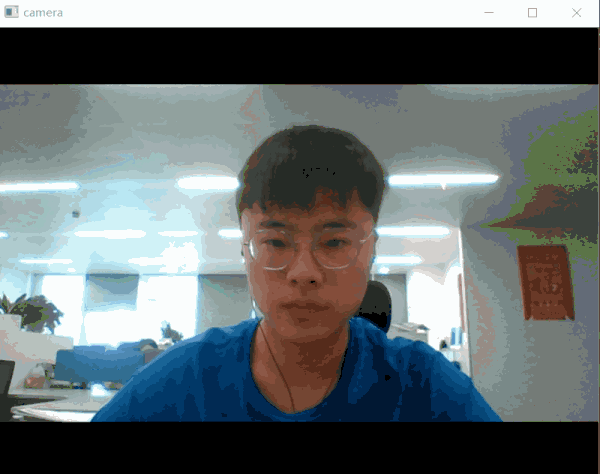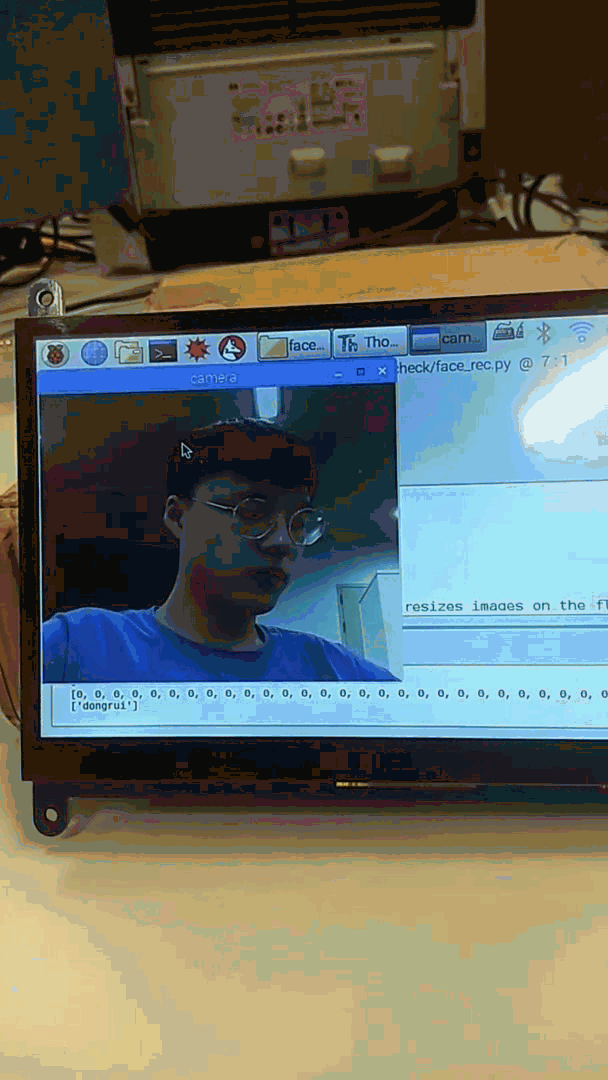背景
源于实习公司的人脸识别打卡系统,完成之前的项目后正好没有事情干,于是想到了这个,公司的这个打卡系统操作流程是这样的,首先用手机把你的人脸录进去,要求绕头半圈,也就是右脸,正脸,左脸,然后你再去摄像头那里,识别到你后就会帮你把门打开,顺便帮你在钉钉上打卡。
功能
我做的是简易版,实现了这个打卡系统的主要功能,能完成:信息录入,正脸识别,开门关门,名字与时间的保存。
硬件
树莓派一个,摄像头一个,显示屏一个
效果
并没有打马赛克,文件大小还被限制了,大家将就着看,
这是在电脑上的效果:

在树莓派上效果:

打卡记录:
看起来效果还是不错的
源码
源码使用的电脑上的源码,其实是差不多的,路径不一样而已
如果树莓派打不开摄像头,参考这个:
https://www.jianshu.com/p/5653b2b7248c
代码注释很全,不详细解释
摄像头测试代码
import cv2
capCamera = cv2.VideoCapture(0)
if(not capCamera.isOpened()):
print("can't open this camera")
exit(0)
capCamera.set(cv2.CAP_PROP_FRAME_WIDTH, 320)
capCamera.set(cv2.CAP_PROP_FRAME_HEIGHT, 240)
while(True):
# handle for the camera
ret, frame = capCamera.read()
if ret == True:
cv2.imshow('camera',frame)
else:
break
# handle for the video
# handle for exit
if (cv2.waitKey(1)) == ord('q'):
break
capCamera.release()
cv2.destroyAllWindows()
录入信息
import cv2
import os
#config
add_name = 'xiaoming'#要录入的人名
target_dir = './pic_dir/{}/'.format(add_name)
if os.path.exists(target_dir) is False:
os.makedirs(target_dir)
def generate():
face_cascade = cv2.CascadeClassifier('.\cascades\haarcascade_frontalface_default.xml')
#打开摄像头
camera = cv2.VideoCapture(0)
forword_count = 0
#正脸采集,一共20张图片
while (forword_count <= 20):
ret, frame = camera.read()
#转化为灰度图像,用来检测人脸
gray = cv2.cvtColor(frame, cv2.COLOR_BGR2GRAY)
faces = face_cascade.detectMultiScale(gray, 1.3, 5)
for (x, y, w, h) in faces:
#画出预测框
cv2.rectangle(frame, (x, y), (x + w, y + h), (255, 0, 0), 2)
f = cv2.resize(gray[y:y + h, x:x + w], (200, 200))
#保存录入的图片
cv2.imwrite('./pic_dir/{0}/{1}.png'.format(add_name, forword_count), f)
print(forword_count)
forword_count += 1
#展示图片
cv2.imshow("camera", frame)
#一秒钟24帧
if cv2.waitKey(1000 // 24) & 0xff == ord("q"):
break
camera.release()
cv2.destroyAllWindows()
if __name__ == "__main__":
generate()
人脸识别
import os
import sys
import cv2
import numpy as np
import time
def change_door(open_later_time,isOpen,new_face_position):
if len(new_face_position) > 0 and isOpen == False:
print('打开')
isOpen = True
if len(new_face_position) == 0 and isOpen == True:
open_later_time += 1
else:
open_later_time = 0
if open_later_time == 100:
open_later_time = 0
print('关闭')
isOpen = False
return open_later_time,isOpen,new_face_position
def read_images(path, sz=None):#给一个地址,返回训练集
c = 0
X, Y = [], []
names = []
for dirname, dirnames, filenames in os.walk(path):#目录,子目录,子文件(只限一层目录)
for subdirname in dirnames:
names.append(subdirname)
subject_path = os.path.join(dirname, subdirname)
for filename in os.listdir(subject_path):#遍历每个名字
try:
if (filename == ".directory"):
continue
filepath = os.path.join(subject_path, filename)
im = cv2.imread(filepath, cv2.IMREAD_GRAYSCALE)
if (im is None):
print("image " + filepath + " is none")
else:
print(filepath)
if (sz is not None):
im = cv2.resize(im, (200, 200))
X.append(np.asarray(im, dtype=np.uint8))
Y.append(c)
except IOError:
print("I/O error({0}): {1}".format(IOError.errno, IOError.strerror))
except:
print("Unexpected error:", sys.exc_info()[0])
raise
print(c)
c = c + 1
print(Y)
print(names)
return [X, Y], names
def face_rec():
image_dir = './pic_dir_1'
isOpen = False
open_later_time = 0
[X, Y] , names = read_images(image_dir)
Y = np.asarray(Y, dtype=np.int32)
model = cv2.face.LBPHFaceRecognizer_create()
model.train(np.asarray(X), np.asarray(Y))
camera = cv2.VideoCapture(0)
camera.set(cv2.CAP_PROP_FRAME_WIDTH, 400)
camera.set(cv2.CAP_PROP_FRAME_HEIGHT, 350)
face_cascade = cv2.CascadeClassifier('./cascades/haarcascade_frontalface_default.xml')
re_count = 0
old_face_position = {}#用来绘制预测框
new_face_position = {}#用来收集新数据
while (True):
#print(old_face_position)
#print(new_face_position)
re_count += 1
read, img = camera.read()
faces = face_cascade.detectMultiScale(img, scaleFactor =1.3, minNeighbors=5)
#print('{}的类型{}'.format(faces, type(faces)))
for (x, y, w, h) in faces:
gray = cv2.cvtColor(img, cv2.COLOR_BGR2GRAY)
roi = gray[x:x + w, y:y + h]
try:
roi = cv2.resize(roi, (200, 200), interpolation=cv2.INTER_LINEAR)
#print(roi.shape)
params = model.predict(roi)
#print("Label: %s, Confidence: %.2f" % (params[0], params[1]))
new_face_position[names[params[0]]] = (x, y, w, h)
except:
continue
#优化用户体验
#采集三帧的人脸识别信息,将预测框画出,预测框三帧一刷新,防止预测框频繁抖动的现象
if re_count == 3:
re_count = 0
#print(new_face_position)
if len(new_face_position) > 0:
for key in new_face_position.keys():
(x, y, w, h) = new_face_position[key]
if old_face_position.__contains__(key) is False:
img = cv2.rectangle(img, (x, y), (x + w, y + h), (255, 0, 0), 2)
cv2.putText(img, key, (x, y - 20), cv2.FONT_HERSHEY_SIMPLEX, 1, 255, 2)
old_face_position[key] = (x, y, w, h)
else:
(o_x, o_y, o_w, o_h) = new_face_position[key]
if abs((o_x-x)) <= 5 and abs((o_y-y)) <= 5:
img = cv2.rectangle(img, (x, y), (x + w, y + h), (255, 0, 0), 2)
cv2.putText(img, key, (x, y - 20), cv2.FONT_HERSHEY_SIMPLEX, 1, 255, 2)
old_face_position[key] = (x, y, w, h)
else:
old_face_position = {}
new_face_position = {}
else:
for key in old_face_position.keys():
(o_x, o_y, o_w, o_h) = old_face_position[key]
img = cv2.rectangle(img, (o_x, o_y), (o_x + o_w, o_y + o_h), (255, 0, 0), 2)
cv2.putText(img, key, (o_x, o_y - 20), cv2.FONT_HERSHEY_SIMPLEX, 1, 255, 2)
#开关门模拟和保存打卡信息
#如果检测到人,并且门没有开,则打开门,并且录入信息
if len(new_face_position) > 0 and isOpen == False:
print('开门')
#保存打卡信息
t = time.strftime('%Y.%m.%d %H:%M:%S', time.localtime(time.time()))
with open('jilu.txt', 'a') as file:
file.writelines('{},{}\n'.format(new_face_position.keys(),t))
isOpen = True
#如果没有检测到人,并且门开了,计数器+1,否则计数器为0
if len(new_face_position) == 0 and isOpen == True:
open_later_time += 1
else:
open_later_time = 0
#当计数器为100的时候关门
if open_later_time == 100:
print('关门')
isOpen = False
open_later_time = 0
cv2.imshow("camera", img)
#树莓派最好将帧数设为最大,不然看起来不舒服
if cv2.waitKey(1000 // 25) & 0xff == ord("q"):
#if cv2.waitKey(1000 // 25) & 0xff == ord("q"):
break
cv2.destroyAllWindows()
if __name__ == "__main__":
face_rec()
结论
在电脑上运行的很流畅,在树莓派上运行的话因树莓派而异,能明显感觉到帧数下降,不过基本功能还是能完成的

